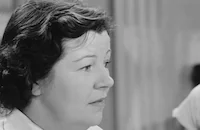The Reformer and the Redhead

Brief Synopsis
Cast & Crew
Norman Panama
June Allyson
Dick Powell
David Wayne
Cecil Kellaway
Ray Collins
Film Details
Technical Specs

Synopsis
Commodore John Balwind Parker, the corrupt boss of the most influential political machine in the town of Oakport, California, has just returned from Africa, where he has been on a hunting safari with his niece, Lily Rayton Parker. John and Lily proudly display their animal trophies at the city zoo, much to the disappointment of Dr. Kevin G. Maguire, the zoo superintendent, who does not believe in hunting wild animals. Kevin is later fired from his job, which angers his quick-tempered daughter Kathleen, who works as a tour guide at the zoo. Kathy knows that her father was fired because he opposed the commodore's decision to place his mounted trophies on the walls of the zoo offices. She shows her displeasure at the Parkers' influence on the zoo commission by interrupting their trophy presentation and protesting their cruelty to animals. An argument ensues between Lily and Kathy, and ends in a fistfight. When Kathy is charged with assault and battery, disturbing the peace and suspicion of inciting a riot, she turns to her friend, reporter Tim Harveigh, for help. Tim suggests that she appeal her case to attorney Andrew Rockton Hale, who is running for mayor of Oakport as a reformer and as a "champion of the underdog." Tim and Kathy are unaware, however, that Andrew has been making empty campaign promises and plans to align himself with Parker's political machine to get an advantage in the race. After meeting with Parker and realizing that Parker intends to make him his puppet, however, Andrew decides to postpone the alliance until he can better negotiate the arrangement through blackmail. Kathy unwittingly gives Andrew information with which to blackmail Parker when, while telling her hard luck story, she mentions Parker's corrupt influence on zoo officials. To prove her assertions, Kathy takes Andrew to her ranch to meet her father, who knows more about Parker's dealings. At the ranch, Andrew has his first encounter with the Maguires' unconventional pets, including their lion, Caeser, who gives him a fright. After growing accustomed to the lion's presence, Andrew eventually turns his attentions to Kathy and they spark a romance. Later, while Andrew visits the state capitol offices in Sacramento to investigate Parker's involvement in a questionable construction deal, Kathy, who has learned that Andrew was an orphan, enlists a group of children at the Oakport Orphanage to help with his campaign. When Andrew returns from Sacramento with evidence of Parker's corruption, he makes a secret deal with him to suppress the evidence in exchange for his unconditional support. Kathy and Andrew become engaged, but Kathy breaks off the engagement when Tim tells her about Andrew's secret deal with Parker. The break-up forces Andrew to realize his errors and, during a live radio show, he publicly reveals his deal with Parker. Andrew leaves the studio unaware that Herman, a dangerous lion, has escaped from the zoo and is roaming the streets of Oakport. While driving through town, Andrew sees the lion and, believing that it is Caesar, fearlessly prods him into his car. Kathy eventually finds Andrew, and he faints when she tells him that he has befriended a killer lion. Kathy revives Andrew and gives him a big kiss to show her admiration for his bravery in exposing Parker.

Cast

June Allyson

Dick Powell

David Wayne

Cecil Kellaway

Ray Collins

Robert Keith

Marvin Kaplan

Kathleen Freeman
Wally Maher
Alex Gerry
Charles Evans

Paul Maxey
Matt Moore
Wilson Wood
Charles Wagenheim
Joel Allen

John Hamilton
Frank Sully
Danny Richards Jr.
Frances Dominguez
Robert Espinoza
Paul Regas
Roman Pochylski
Mario Siletti
Pasquale Costantini
Spencer Chan
Hayward Soo Hoo
Gil Herman
Michael Chapin
Nacho Galindo
Sven Hugo Borg
Theodore Von Eltz
Peter Chong

Jerry Paris
Gilbert Wilson
Ralph Montgomery

Mae Clarke

Spring Byington
Kenny Washington
Simon "stuffy" Singer
Betty Jane Howarth
Tor Johnson

Bridget Carr
Henry Sylvester
Ed Peil Sr.
Herman, The Lion
Grace Gillern

Margaret Bert
Kenneth Garcia
Marjorie Jackson
Marvin Jones
Helen Eby-rock
Peggy Lyon
George Boyce
Cameron Grant
Crew
Peter Ballbusch
Robert Bronner
Jack Dawn
Dale Deverman
Otto Dyar
Joe Edmondson
William Ferrari
Melvin Frank
Melvin Frank
Joel Freeman
Gene Gaudio
Cedric Gibbons
A. Arnold Gillespie
Sydney Guilaroff
Nolan Hurst
Eylla Jacobus
Ray June
Howard Koch
Jack D. Moore
Warren Newcombe
Norman Panama
Norman Panama
Harry Parkins
Mervyn Price
David Raksin
Irving Ries
Helen Rose
Douglas Shearer
George White
Edwin B. Willis
Edward Woehler
Charles Zacha

Photo Collections
Videos
Movie Clip



Trailer
Hosted Intro
Film Details
Technical Specs

Articles
The Reformer and the Redhead
In The Reformer and the Redhead, Powell plays an attorney with political ambitions. He soon finds himself enlisted by the hot-tempered daughter of a zookeeper to help her father, who has lost his job for political reasons. Campaigning for mayor, Powell goes after the corrupt incumbent but almost loses the redhead when she suspects their budding romance is only political maneuvering. It all manages to end happily when Powell makes friends with one of Allyson+s favorite zoo animals, an affectionate lion named Herman.
Allyson later said she worked harder with her husband (whom she always called "Richard") than with any other co-star because she was afraid the public would see her, not as an actress, but only as his wife. This was aggravated by the fact that Allyson, once cast as the girl-next-door because of her sunny nature and adorable raspy voice, was by this point moving into a career phase that saw her being saddled with a new screen stereotype - sweet, supportive wives, most notably opposite James Stewart in The Stratton Story (1949), The Glenn Miller Story (1953), and Strategic Air Command (1955). In The Reformer and the Redhead, her character wasn't married yet but she was still playing an older version of the ing¿e role - spunky and girlish (though 33 years old at the time). It would be several years before she had her revenge on this typecasting, turning in a critically praised performance as Jose Ferrer's bitch wife from hell in The Shrike (1955).
Powell, 13 years older than his young wife, had gone through a similar typecasting struggle years earlier. A former band singer, he was signed to Warner Brothers in the 1930s for a string of crooner roles as the "juvenile lead" in such musicals as 42nd Street (1933), Dames (1934), and the "Gold Diggers" series, films that often featured his second wife, Joan Blondell. Powell tried hard to escape the rut the studio put him in, but that wouldn+t happen until several years after he left Warners. He fought hard for the role of Raymond Chandler's immortal private eye Philip Marlowe in Murder, My Sweet (1944). His success in that part immediately turned his career around; once stereotyped as the clean-cut crooner, he now became one of the screen's pre-eminent tough guys of the late 40s.
By the time he made The Reformer and the Redhead, Powell was beginning to move into a new phase of his career. In her autobiography, Allyson said that while they were working on the picture, Powell studied and analyzed every aspect of the production. "We discussed his performance, how camera work could have been improved, lighting, angles at which a sequence had been shot," she noted. "He said he was in training to produce movies himself someday." His first producer assignment was for TV's Four Star Playhouse in 1952. His first feature as director was Split Second (1953). Over the next five years he directed and produced four more. It was production on one of these, The Conqueror (1956), that led many to speculate that it was responsible for his premature death in 1963. Filmed in Utah close to a nuclear test site, the set was likely to have been contaminated by radioactive fallout. Also, dirt from the location shoot was transported back to Hollywood to match the studio produced segments. Within a relatively short time, a disproportionate number of the cast and crew - including John Wayne, Susan Hayward, Agnes Moorehead, and Powell himself - developed cancer and died.
The Reformer and the Redhead marked the beginning of another "marriage," one of a professional rather than romantic nature. The movie lists Melvin Frank and Norman Panama as producers, directors, and screenwriters, the first of seven to co-credit the duo this way. They began collaborating as students at the University of Chicago, and later on the radio after moving to Hollywood in the late 1930s. This led directly to their first film script, the Bob Hope comedy My Favorite Blonde (1942). The two co-wrote several scripts throughout the 1940s before joining forces as multiple hyphenates with this project. In addition to their triple-duty productions, they worked together on several more over the decade, in one capacity or another, including a collaboration on the film version of their Broadway hit Li'l Abner (1959).
Directors/Producers: Melvin Frank, Norman Panama
Screenplay: Melvin Frank, Norman Panama; story by Robert Carson
Cinematography: Ray June
Editing: George White
Art Direction: William Ferrari, Cedric Gibbons
Original Music: David Raksin
Cast: Dick Powell (Andrew Rockton Hale), June Allyson (Kathleen Maguire), David Wayne (Arthur Colner Maxwell), Cecil Kellaway (Dr. Kevin Maguire), Ray Collins (Commodore Parker), Robert Keith (Tim Harveigh).
BW-90m. Closed captioning.
by Rob Nixon

The Reformer and the Redhead
Quotes
Trivia
Notes
The onscreen credits incorrectly list actor Charles Evans as "Charles Evens." Hollywood Reporter news items in February 1949 indicate that Lana Turner and Robert Taylor were originally set for the roles played by June Allyson and Dick Powell. Allyson and Powell were married in real life. This was the first of two films that they made together. The Reformer an the Redhead was the first picture directed and produced by Norman Panama and Melvin Frank, who had previously worked as a writing team for radio, theater and film. Modern sources note that the film was made at a final cost of $1,230,000. In her autobiography, Allyson stated that she had a childhood phobia of cats and was terrified of working with lions on the set. Allyson and Powell recreated their roles for a Lux Radio Theatre adaptation of the story, which aired on June 25, 1951.


















